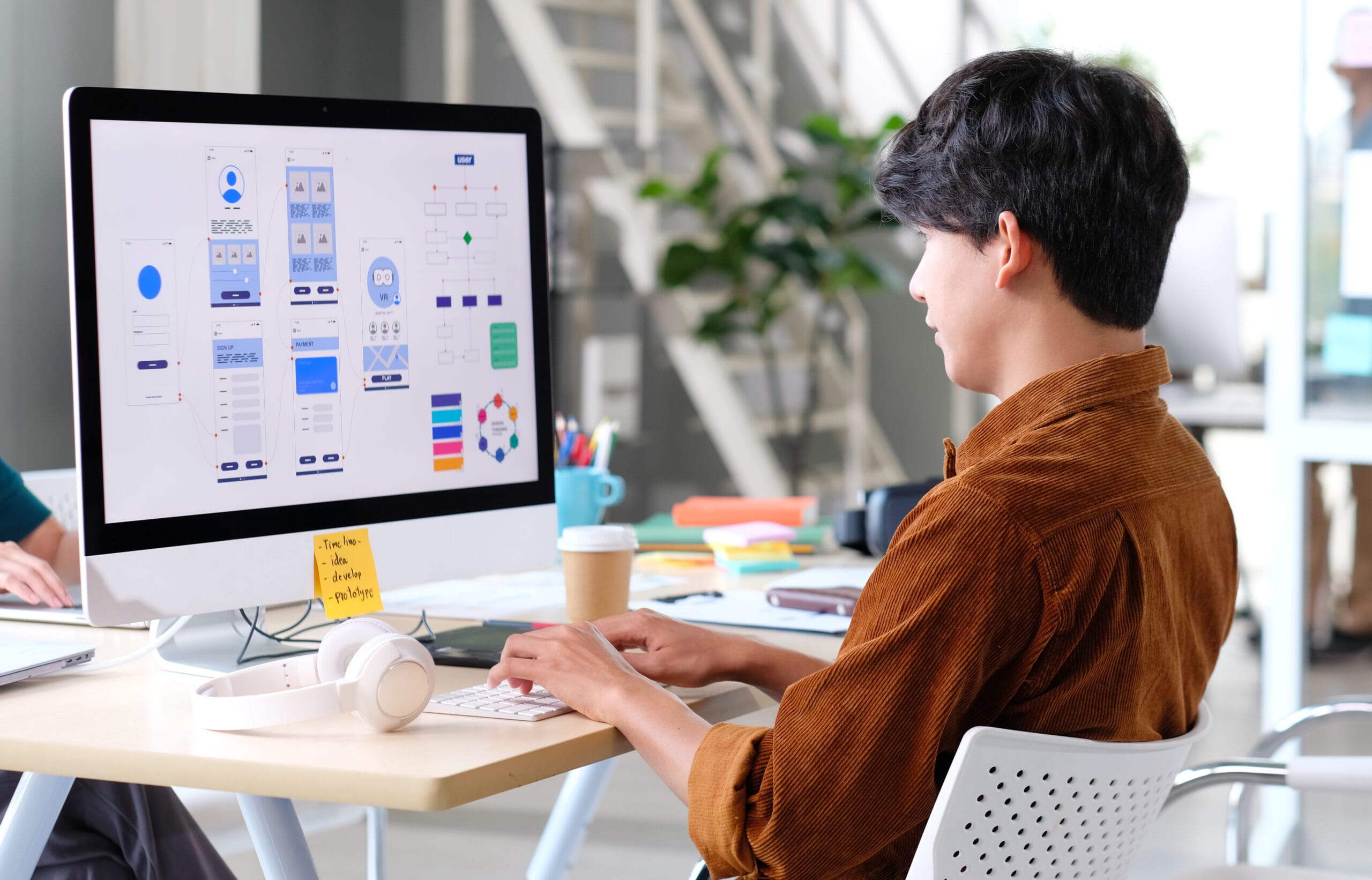Checking Out Imaginative Patterns in Web Design for Modern Companies
The landscape of web design is consistently advancing, reflecting the vibrant requirements of modern services. Recent trends highlight a choice for minimalism, strong typography, and engaging interactivity. Companies progressively prioritize user experience through mobile-first principles and tailored content. Furthermore, a concentrate on sustainability is acquiring grip. Understanding these fads is necessary for organizations aiming to attract attention in a crowded market. What effects do these shifts hold for the future of digital engagement?
Embracing Vibrant Typography
Strong typography has actually become a defining aspect in modern web design, capturing attention and conveying messages with striking quality. This pattern focuses on aesthetically impactful message that boosts user engagement and brand name identity. Designers typically use large fonts and distinct fonts to produce a hierarchy, leading audiences through content seamlessly.
The calculated use vibrant typography enables effective narration, allowing brand names to communicate their worths succinctly. It offers not only aesthetic functions yet also useful ones, as it improves readability across devices and display sizes.
As internet sites complete for user focus, bold typography attracts attention in a saturated electronic landscape. Its flexibility allows designers to explore contrasting colors and layouts, better intensifying its efficiency. Eventually, welcoming bold typography stands for a change in the direction of more expressive and communicative web design, fostering a much deeper connection in between brands and their audiences.
The Rise of Minimalist Layout
As electronic environments come to be significantly messy, the rise of minimal style supplies a revitalizing alternative that focuses on simplicity and performance. This layout philosophy strips away unneeded components, allowing content to take facility stage. By concentrating on tidy lines, enough white area, and a minimal color scheme, minimalist layout improves user experience and boosts navigation.
Companies embracing this trend purpose to convey their brand name message plainly and efficiently, fostering a sense of calm and clearness. The lack of diversions assists users focus on vital details, resulting in enhanced interaction and conversion prices. In addition, minimalist layout aligns well with mobile-first methods, ensuring that web sites continue to be obtainable and user-friendly throughout various devices.
Ultimately, the rise of minimalist layout shows a wider change in the direction of focusing on user requirements and preferences, making it an effective device for modern businesses wanting to make a lasting impact in the electronic landscape.
Immersive Animations and Interactivity
While many web designers welcome minimal appearances, another compelling trend getting traction is making use of immersive computer animations and interactivity. This technique enhances user interaction by developing interesting experiences that draw visitors right into the material. Designers use dynamic elements such as computer animated histories, scrolling results, and interactive infographics to communicate intricate concepts in an obtainable way.
These computer animations not only give aesthetic interest however additionally guide individuals via the navigation process, making communications more instinctive. For example, hover effects and animated shifts can urge customers to check out better, bring about enhanced time invested in the website.
In addition, this fad lines up with the broader activity towards storytelling in web design, where computer animations act as narrative tools that communicate brand name messages efficiently. By incorporating immersive computer animations and interactivity, companies can differentiate themselves in a crowded online landscape, ultimately enhancing user fulfillment and brand name loyalty.
Mobile-First Layout Concepts
Mobile-first style principles stress focusing on user experience by guaranteeing websites work flawlessly on smaller displays. This method incorporates receptive design strategies that adjust to different tool dimensions while keeping aesthetic integrity. Additionally, it concentrates on touchscreen navigating style, boosting functionality for mobile users.
Prioritizing User Experience
Exactly how can designers properly prioritize user experience in a significantly mobile-centric globe? Emphasizing mobile-first style principles is important, as users largely involve with internet sites through mobile devices. This method motivates developers to improve material, guaranteeing it is accessible and quickly accessible on smaller screens. Trick see it here techniques include streamlining navigating, minimizing lots times, and employing touch-friendly elements that enhance interactivity. In addition, prioritizing legible typography and intuitive formats can substantially boost user satisfaction. Designers need to continuously gather user comments to fine-tune their approaches, adapting to progressing user requirements and choices. By concentrating on these elements, businesses can produce an appealing electronic experience that promotes loyalty and drives conversions, inevitably lining up with the expectations these days's mobile individuals.
Receptive Design Methods
Designers embrace responsive format methods to create flexible and adaptable web experiences that satisfy various display dimensions. This approach prioritizes mobile-first style concepts, making sure peak performance on smaller sized devices prior to scaling up for larger displays. By making use of liquid grids, versatile images, and media queries, developers can maintain a cohesive visual identity across all platforms. This method not only improves user engagement but additionally boosts internet search engine positions, as mobile-friendly sites are favored by search algorithms. Additionally, receptive formats allow organizations to reach a wider target market, suiting individuals on desktops, tablet computers, and smart devices alike. On the whole, applying these techniques is vital for modern-day web design, guaranteeing that companies stay competitive in an ever-evolving electronic landscape.
Touchscreen Navigating Layout
With the rise of mobile phones, touchscreen navigating has actually ended up being a fundamental aspect of web design. Developers are increasingly embracing mobile-first concepts to boost user experience and engagement. Web Design Agency. Reliable touchscreen navigation prioritizes bigger switches and user-friendly gestures, permitting individuals to interact easily with material. This strategy reduces disappointment and motivates expedition, as customers can navigate seamlessly with their fingers. Additionally, incorporating swipe gestures and tap functionality provides to the all-natural habits of mobile customers. Feedback systems, such as visual cues and animations, enhance usability better by verifying actions. As touchscreens dominate user interactions, employing these design components not just straightens with contemporary assumptions but likewise cultivates an extra delightful and obtainable browsing experience for all individuals
Individualized User Experiences
What makes a user feel truly engaged on a website? The answer typically depends on individualized user experiences. By customizing web content and navigation to specific choices, organizations can develop a significant connection with their target market. This customization can be achieved via numerous approaches, such as analyzing user behavior, making use of cookies, and using tailored recommendations based on previous communications.
Ecommerce systems that suggest items based on browsing background not only enhance user experience yet also raise conversion prices. Moreover, including dynamic web content that adapts to the user's area or time of day can additionally enhance engagement.
Furthermore, tailored greetings or messages can make individuals feel valued and recognized. As contemporary businesses strive to stand apart in a competitive digital landscape, accepting individualized user experiences becomes vital, visit this page promoting loyalty and motivating repeat sees. Eventually, this method transforms a common web site right into an interactive system that reverberates with its audience.
Sustainability in Web Design
As the digital landscape continues to develop, the significance of sustainability in web design has actually obtained substantial focus. Developers are significantly mindful of the ecological influence their productions can have, motivating a shift towards eco-friendly techniques (Web Design Agency). Sustainable web design concentrates on enhancing sites to reduce energy intake and carbon impacts. Approaches include using minimalistic layout concepts, maximizing pictures, and utilizing effective coding methods to boost loading speeds
The selection of hosting service providers plays an important function; several developers are now deciding for green organizing services powered by sustainable energy. By try this prioritizing ease of access and straightforward navigating, sustainable designs also satisfy a more comprehensive target market, boosting usability. This conscious method not just interest environmentally-minded customers yet also contributes to the overall long life and effectiveness of web sites. Ultimately, sustainability in web design reflects an expanding fad in the direction of liable digital techniques that line up with modern-day service worths.

Frequently Asked Questions
How Can I Choose the Right Color Scheme for My Internet site?
To select the ideal color plan for an internet site, one should think about the brand's identification, target market, and psychological effect. Using color concept and testing mixes can boost user experience and aesthetic charm considerably.
What Are the most effective Devices for Prototyping Website Design?
The most effective tools for prototyping website design include Figma, Sketch, Adobe XD, and InVision. These platforms offer instinctive user interfaces, collaboration features, and considerable collections, making them optimal for designers to produce and fine-tune their principles properly.
How Do I Measure the Efficiency of My Web Design?
To measure web design performance, one must examine user interaction metrics, conversion rates, and functionality feedback (Website Design Agency). A/B screening and heatmaps can likewise give understandings right into user actions, assisting required changes for improved efficiency and user experience
What Prevail Web Design Mistakes to Avoid?
Typical web design errors include chaotic layouts, bad navigating, slow packing times, absence of mobile optimization, inadequate comparison, and disregarding user feedback. Staying clear of these risks boosts user experience and enhances overall effectiveness of the website.
How Often Should I Update My Internet Site Style?
A site design ought to be updated every a couple of years, or earlier if considerable changes in branding or technology happen. Normal updates keep the site fresh, functional, and aligned with current user assumptions.
